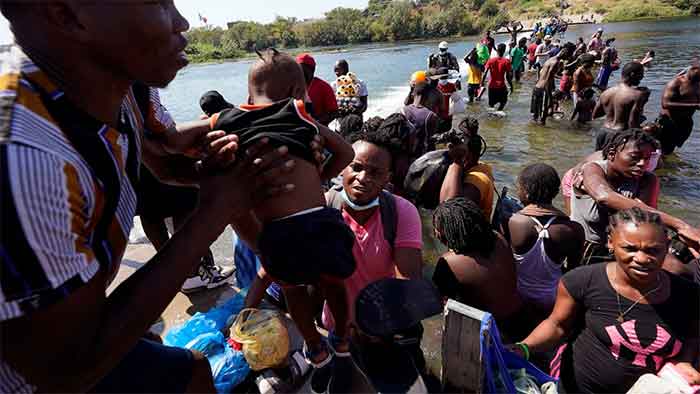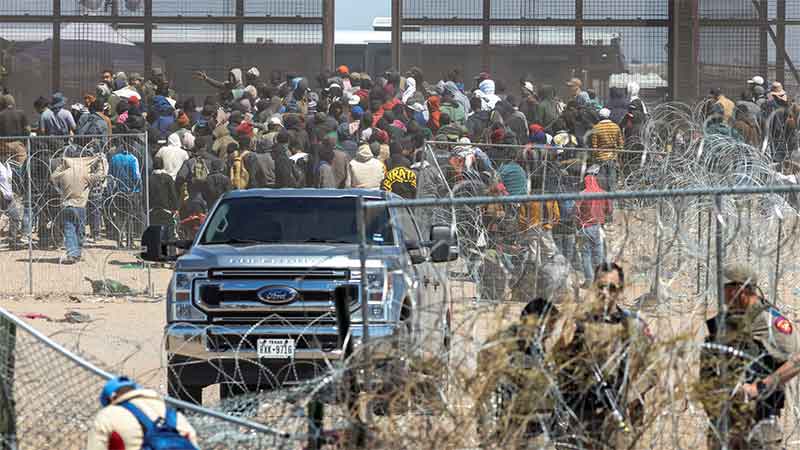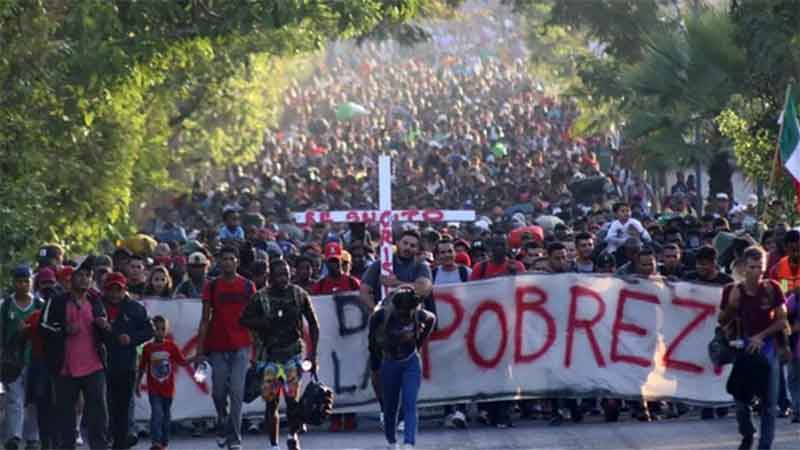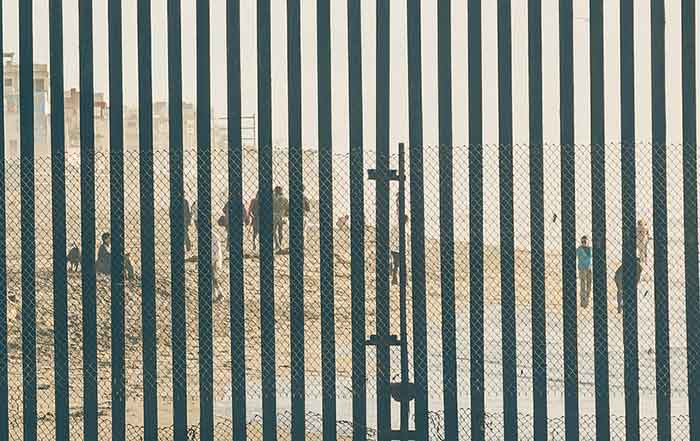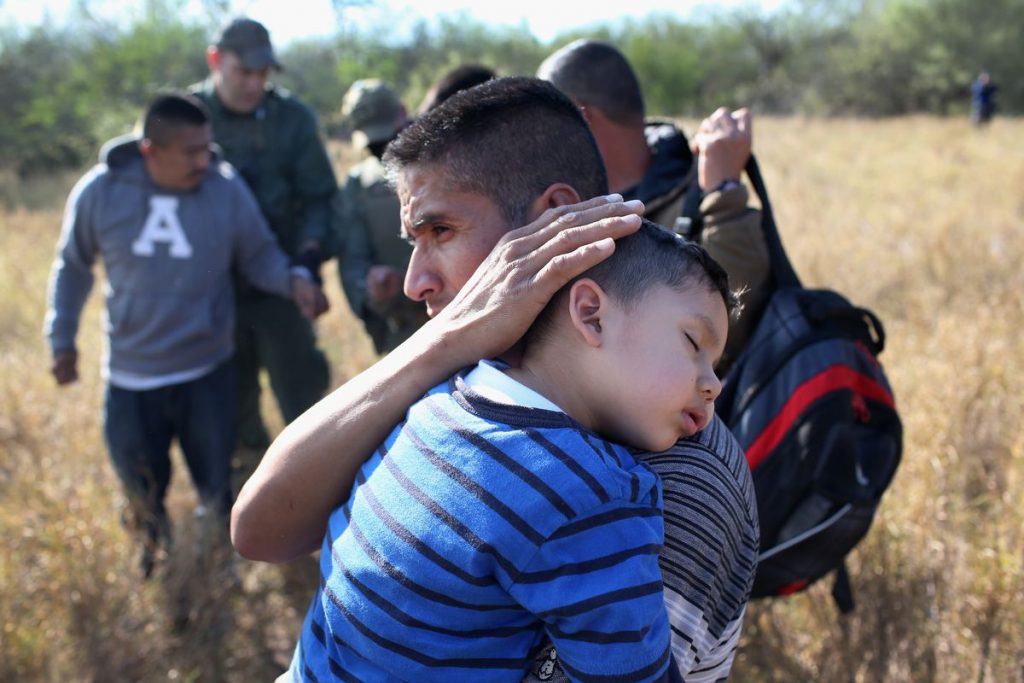In a massive show of force, the U.S. Customs and Border Protection (CBP) mounted officers attempted to contain migrants as they crossed the Rio Grande from Ciudad Acuña, Mexico, into Del Rio, Texas, on September 19, 2021. Thousands of Haitian migrants have been arriving to Del Rio, Texas, as authorities attempt to close the border to stop the flow of migrants.
At the same time, the U.S. flew Haitians camped in a Texas border town back to their homeland Sunday and tried blocking others from crossing the border from Mexico that signaled the beginning of what could be one of America’s swiftest, large-scale expulsions of migrants or refugees in decades. In all, U.S. authorities moved to expel many of the more 12,000 migrants camped around a bridge in Del Rio, Texas, after crossing from Ciudad Acuña, Mexico.
Texas Governor Greg Abbott said the number reached as high as 16,000 on Saturday. Many had traveled from as far south as Chile, hoping to apply for asylum in the U.S.
On Monday, as temperatures soared to 40 Celsius, migrants complained about continued shortages of food and water in the camp. Some of those crossing back into the U.S. could be seen balancing large bags of ice on their heads as they waded through the water.
More than 320 migrants arrived in Port-au-Prince on three flights, and Haiti said six flights were expected Tuesday — three in Port-au-Prince and three in the northern city of Cap-Haitien, said Jean Négot Bonheur Delva, Haiti’s migration director.
The U.S. plans to begin seven expulsion flights daily on Wednesday, four to Port-au-Prince and three to Cap-Haitien, according to a U.S. official who was not authorized to discuss the matter publicly. Flights will continue to depart from San Antonio but authorities may add El Paso, the official said.
The only obvious parallel for such an expulsion without an opportunity to seek asylum was in 1992 when the U.S. Coast Guard intercepted Haitian refugees at sea, said Yael Schacher, senior U.S. advocate at Refugees International whose doctoral studies focused on the history of U.S. asylum law.
Similarly large numbers of Mexicans have been sent home during peak years of immigration but over land and not so suddenly.
When the U.S. border was closed Sunday, the migrants initially found other ways to cross nearby until they were confronted by federal and state law enforcement.
Haitian immigrants were still crossing the river into the U.S. about 2.4 kilometers east of the previous spot, but they were eventually stopped by Border Patrol agents on horseback and Texas law enforcement officials.
As they crossed, some Haitians carried boxes on their heads filled with food. Some removed their pants before getting into the river and carried them. Others were unconcerned about getting wet.
Agents yelled at the migrants who were crossing in the waist-deep river to get out of the water. The several hundred who had successfully crossed and were sitting along the river bank on the U.S. side were ordered to the Del Rio camp. “Go now,” agents yelled. Mexican authorities in an airboat told others trying to cross to go back into Mexico.
Haitians have been migrating to the U.S. in large numbers from South America for several years, many having left their Caribbean nation after a devastating 2010 earthquake. After jobs dried up from the 2016 Summer Olympics in Rio de Janeiro, many made the dangerous trek by foot, bus and car to the U.S. border, including through the infamous Darien Gap, a Panamanian jungle.
Since Friday, 3,300 migrants have already been removed from the Del Rio camp to planes or detention centers, Border Patrol Chief Raul L. Ortiz said Sunday. He expected to have 3,000 of the approximately 12,600 remaining migrants moved within a day, and aimed for the rest to be gone within the week.
The rapid expulsions were made possible by a pandemic-related authority adopted by former U.S. President Trump in March 2020 that allows for migrants to be immediately removed from the country without an opportunity to seek asylum. U.S. President Joe Biden exempted unaccompanied children from the order but let the rest stand.
Some people arriving Haiti on the first flight covered their heads as they walked into a large bus parked next to the plane. Dozens lined up to receive a plate of rice, beans, chicken and plantains as they wondered where they would sleep and how they would make money to support their families.
All were given $100 and tested for COVID-19, though authorities were not planning to put them into quarantine, said Marie-Lourde Jean-Charles with the Office of National Migration.
U.S. removes Haitian migrants at Mexico border
Other media reports said on September 20, 2021:
Agents at the U.S. border with Mexico have begun moving thousands of Haitian migrants sheltering under a bridge in the Texas town of Del Rio.
The increasingly poor conditions under the Del Rio International Bridge – which connects the Texas city with Mexico – led the U.S. Department of Homeland Security (DHS) to accelerate flights to Haiti and other destinations within the next 72 hours.
The DHS over the weekend said that some 2,000 people were moved to other immigration processing stations on Friday, as the town has been overwhelmed by an influx of Haitian and other migrant groups.
While migrants seeking jobs and safety have been making their way to the U.S. for months, it is only in recent days that the number converging on Del Rio has drawn widespread attention, posing a humanitarian and political challenge for the Biden administration.
White House condemns border guard use of whip-like cord against migrants
A Reuters report said:
The White House on Monday criticized the use of horse reins to threaten Haitian migrants after images circulated of a U.S. border guard on horseback charging at migrants near a riverside camp in Texas.
Reuters witnesses saw mounted officers wearing cowboy hats blocking the paths of migrants, and one officer unfurling a cord resembling a lariat, which he swung near a migrant’s face.
A video showing a border guard apparently threatening migrants with the cords was shared on social media.
“I don’t think anyone seeing that footage would think it was acceptable or appropriate,” White House spokeswoman Jen Psaki told reporters.
“I don’t have the full context. I can’t imagine what context would make that appropriate,” she added.
Some on social media commented that the image of fleeing Black men chased by white officers on horseback had echoes of the historical injustices suffered by Black people in the U.S.
U.S. Border Patrol Chief Raul Ortiz said the incident was being investigated.
Department of Homeland Security Secretary Alejandro Mayorkas said the long reins are used by mounted officials to “ensure control of the horse.”
“But we are going to investigate the facts,” he said during a news conference in Del Rio.
“This treatment they are giving is racism, because of the color of our skin,” said Maxon Prudhomme, a Haitian migrant on the banks of the Rio Grande in Mexico.
As the sun was setting, about 200 migrants on the Mexican side bivouacked in a field by the river, flattening cardboard boxes and unfurling blankets to sleep under a cluster of trees.
Some migrants said they returned to Mexico in search of food and water, while others crossed due to fears they would be deported back to Haiti on flights organized by U.S. authorities.
U.S. officials closed the Del Rio border crossing last Friday due to the crush of migrants, and said Monday it remained shuttered, with most traffic re-routed to the Eagle Pass, Texas, border crossing, 90 km south.
A surge of 600 border agents and other personnel have been deployed to the area.
While President Joe Biden rolled back many of his predecessor Donald Trump’s hardline immigration policies earlier this year, he left in place a sweeping pandemic-era expulsion policy under which most migrants caught crossing the U.S.-Mexico border are quickly turned back.
Images that seemed to show U.S. border guards using reins as whips against the Haitian migrants only added to the sense that the White House was once more overtaken by the rapidity of a worsening situation.
Psaki struggled to decry the particulars without also condemning the administration’s own position, which appears to leave little hope for the Haitians now huddled on the banks of the Rio Grande.
“If Biden continues with these deportations, he’s no better than Trump,” one Haitian deportee told the Washington Post.
Michael Clemens, a senior fellow at the Center for Global Development, said Haitians who had already been living in Central or Latin America were “easy prey for well-established smuggling networks” that falsely promised amnesty once the migrants reached the U.S.
An outdated and ineffectual immigration system is to blame, Clemens believes. “Why didn’t they ‘get in line’ and migrate ‘the right way’? Because there is no line,” he says. “The U.S. provides essentially zero lawful migration opportunities accessible to almost all Haitian nationals.”
Biden has not yet addressed the situation in Del Rio, but Psaki’s struggles to answer questions during Monday’s briefing served to illustrate the bind in which the administration finds itself. She had trouble explaining why, for example, Afghan refugees appeared to be receiving significantly better treatment than their Haitian counterparts, or how an administration that had promised a much more humane immigration policy than that of Biden’s predecessor, Trump, had resorted to deportation.
Nor did she say that any border guards who may have used whips on migrants would be fired, even as she acknowledged that the footage of them evidently doing so was “horrific.”
Conservatives seized on the images from Del Rio to paint Biden as an ineffectual protector of U.S. borders, though there is little evidence that his own policies are directly responsible for the influx from Haiti.
Trump, who fashioned himself a border lawman, issued a statement on Sunday seemingly intended to stoke his followers’ outrage. “Our Country is rapidly becoming a cesspool of humanity,” Trump said in his statement. “Murderers, drug dealers, and criminals of all shapes and sizes are a big part of this massive migration,” he added, in a reminder of the xenophobia-laden 2015 speech that launched his quest for the White House.
Options shrink for Haitian migrants straddling Texas border
From Del Rio, Texas, an AP report said:
The options remaining for thousands of Haitian migrants straddling the Mexico-Texas border are narrowing as the United States government ramps up to an expected six expulsion flights to Haiti Tuesday and Mexico began busing some away from the border.
U.S. officials faced criticism for using horse patrols to stop them from entering the town.
That was enough for some Haitian migrants to return to Mexico, while others struggled to decide on which side of the border to take their chances.
Authorities stopped some bus lines from operating in the state of Coahuila in an effort to force them not to carry migrants, said Luis Ángel Urraza, president of the local chamber of commerce.
He said the U.S. government’s decision to close the bridge connecting Ciudad Acuna and Del Rio was wearing on the city’s merchants who were counting the days until the migrant population dropped enough to reopen it.
Mayorkas and U.S. Border Patrol Chief Raul Ortiz said they would look into agents on horseback using what appeared to be whips and their horses to push back migrants at the river between Ciudad Acuña and Del Rio, a city of about 35,000 people 230 kilometers west of San Antonio where thousands of migrants remain camped around a bridge.
Whips
The U.S. Border Patrol has been accused of “cruelty” toward Haitian immigrants crossing into Texas, as an activist claimed its agents used “whips” against them. The agency says mounted agents used reins to control their horses.
Amid the ongoing drama with migrants crossing the US-Mexico border at a stretch of the Rio Grande near the small Texas town of Del Rio, a Democrat activist claimed that mounted BP agents were “rounding up Haitian refugees with whips.”
“This is unfathomable cruelty towards people fleeing disaster and political ruin. The administration must stop this,” tweeted Sawyer Hackett, director of People First Future, a political action committee set up by Democrat Julian Castro.
Hackett posted a photo taken by AFP, as well as a video from the border, showing mounted BP agents trying in vain to stop Haitian migrants from wading back and forth across the river. One of the men in the video says, in Spanish, that he was crossing back into Mexico to buy food and diapers for his children.
U.S. Border Patrol officials have repeatedly told reporters their agents do not carry whips, and that the objects seen in the photos and videos are reins for the horses.
At one point in the video shared by Hackett, a mounted BP agent can be seen spinning the reins, but at no point do photos or videos show anyone getting hit.
One of the reasons the man in the video spoke Spanish is that very few of these migrants were actually coming directly from Haiti. According to reporters on the border, they had been living in various Latin American countries – as distant as Chile – but made their way to the US after hearing the Biden administration was stopping deportations, letting in asylum-seekers, and trying to put millions of illegal migrants on a path to citizenship.

